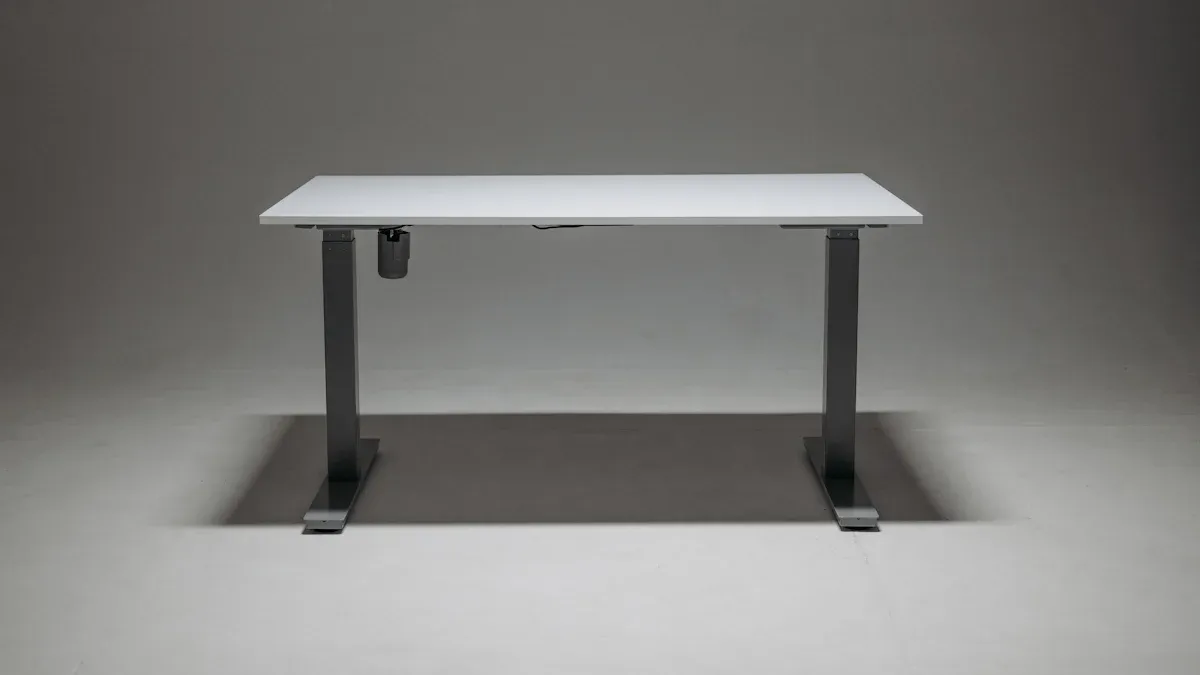
Choosing the best desk for your workspace can feel confusing. You might want a spring sit-stand desk if you prefer quick, manual adjustments without tools. Some desks, like the Pneumatically Adjustable Desk or the Pneumatic Foldable Adjustable Desk, let you change height smoothly with just a gentle lift. Think about how much effort you want to use, how much space you have, and your budget before you decide.
Key Takeaways
- Electric sit-stand desks let you change height easily with a button and work well if you adjust often or have heavy items.
- Spring sit-stand desks use a handle and gas spring for quick, manual height changes and are lighter and more portable.
- Electric desks are quieter than before but may still make some noise; spring desks are almost silent, great for quiet spaces.
- Electric desks cost more and may need repairs, while spring desks are cheaper and need less maintenance.
- Choose a desk based on how often you adjust, your workspace, budget, and personal comfort to find the best fit for you.
How Electric and Spring Sit-Stand Desks Work

Electric Sit-Stand Desk Mechanism
You control an electric sit-stand desk with a button or a small panel. When you press the button, a motor inside the desk moves the surface up or down. The motor uses electricity from a wall outlet. Most electric desks have a digital display that shows the height. Some models let you save your favorite heights. You can switch between sitting and standing with just one touch.
Tip: Electric desks work best if you want to change positions often during the day.
Electric desks can lift heavy items like monitors, computers, and books. The motor does the hard work for you. You do not need to use any force. Some desks move very quietly, but others make a soft humming sound. You should check the noise level if you work in a quiet office.
Spring Sit-Stand Desk Mechanism
A spring sit-stand desk uses a gas spring or pneumatic cylinder. You adjust the height by squeezing a handle or lever. The spring inside helps lift the desk surface. You guide the desk up or down with your hands. You do not need electricity or batteries.
You can move a spring sit-stand desk anywhere because it does not need to plug in. This type of desk is usually lighter than an electric one. You may need to use a little force, especially if you have heavy items on the desk. The movement feels smooth and quick.
- Spring sit-stand desks work well if you want a simple, portable option.
- You can set up your desk in places without power outlets.
Note: Always check the weight limit before placing heavy items on a spring sit-stand desk.
Electric vs. Spring Sit-Stand Desk: Pros and Cons

Ease of Adjustment
You want a desk that makes switching between sitting and standing easy. Electric sit-stand desks let you press a button to change the height. You do not need to use any strength. This feature helps if you adjust your desk many times each day or if you have heavy equipment on your desk.
A spring sit-stand desk uses a handle or lever. You squeeze the handle and guide the desk up or down. The gas spring helps lift the surface, but you still use your hands. If you have a light setup, you will find this process quick and simple. If you have a lot of heavy items, you may need to use more effort.
Tip: If you want the easiest adjustment, choose an electric desk. If you prefer a manual option and do not mind using your hands, a spring sit-stand desk works well.
Speed and Smoothness
Speed and smoothness matter when you change positions often. Electric desks move at a steady pace. Most models take about 10-15 seconds to go from sitting to standing. The movement feels smooth because the motor controls the speed.
Spring sit-stand desks move faster. You can lift or lower the desk in just a few seconds. The gas spring gives a gentle boost, so the motion feels light and quick. You control the speed with your hands, so you can stop at any height.
Here is a quick comparison:
| Feature | Electric Desk | Spring Sit-Stand Desk |
|---|---|---|
| Speed | Moderate (10-15 sec) | Fast (2-5 sec) |
| Smoothness | Very smooth | Smooth, but hand-guided |
Noise Level
Noise can affect your focus, especially in a quiet office. Electric desks use a motor, so you may hear a soft hum or whirring sound when the desk moves. Some models are quieter than others. You should check the noise level if you work in a shared space.
A spring sit-stand desk does not use a motor. You will hear almost no noise when you adjust the height. The only sound comes from the movement of the desk or the handle. This makes it a good choice if you want a silent workspace.
Note: If you need a quiet desk, a spring sit-stand desk offers the best option.
Portability and Weight
You may want to move your desk from one room to another. Portability and weight matter if you like to rearrange your workspace or need to store your desk when not in use. Electric sit-stand desks often weigh more because they have motors and metal frames. You may find it hard to move them alone. Some models need two people to lift or shift.
A spring sit-stand desk usually weighs less. You can carry it by yourself in most cases. You do not need to worry about power cords or outlets. This type of desk works well if you want a flexible setup or if you work in different locations.
Tip: If you want a desk that you can move easily, choose a spring sit-stand desk.
Here is a quick comparison:
| Feature | Electric Desk | Spring Sit-Stand Desk |
|---|---|---|
| Weight | Heavy (50-100+ lbs) | Light (20-50 lbs) |
| Portability | Low | High |
| Needs Power? | Yes | No |
Reliability and Maintenance
You want your desk to last a long time. Electric sit-stand desks have motors and electronic parts. These parts can wear out over time. Sometimes, you may need to replace the motor or fix the control panel. You should check the warranty before you buy. Some brands offer good support and replacement parts.
A spring sit-stand desk has fewer moving parts. You do not need to worry about motors or wires. The gas spring may lose pressure after many years, but most users do not face problems for a long time. You can keep your desk working well by cleaning it and checking the moving parts.
- Electric desks may need more care and repairs.
- Spring sit-stand desks need less maintenance.
Note: Always follow the care instructions from the manufacturer to keep your desk in good shape.
Cost and Value
You want to get the best value for your money. Electric sit-stand desks usually cost more. The price covers the motor, electronics, and extra features like memory settings. You may pay between $300 and $1,000 for a good electric desk. Some high-end models cost even more.
A spring sit-stand desk costs less. You can find many options between $150 and $400. You do not pay for motors or digital controls. This type of desk gives you a simple way to switch between sitting and standing without spending too much.
Think about what features matter most to you. If you want easy adjustment and extra features, an electric desk may be worth the higher price. If you want a budget-friendly option, a spring sit-stand desk gives you good value.
Remember: The best desk fits your needs and your budget.
Safety and Hazards of Sit-Stand Desks
Electric Desk Safety Features
You want your workspace to be safe. Electric sit-stand desks come with built-in safety features to protect you and your equipment. Most electric desks have an anti-collision system. This system stops the desk if it hits an object while moving up or down. You do not have to worry about pinching your fingers or damaging things under the desk.
Some electric desks include a child lock. This feature keeps kids from changing the height by accident. Many models also have overload protection. If you put too much weight on the desk, the motor will stop to prevent damage.
Tip: Always plug your electric desk into a grounded outlet. This step helps prevent electrical hazards.
Here is a quick look at common safety features:
| Feature | What It Does |
|---|---|
| Anti-collision | Stops desk if it hits an object |
| Child lock | Prevents accidental adjustments |
| Overload protection | Stops motor if desk is too heavy |
Spring Sit-Stand Desk Safety Considerations
A spring sit-stand desk uses a gas spring to help you lift and lower the surface. You control the movement with your hands. This design means you need to pay attention to how you adjust the desk. If you let go of the handle too quickly, the desk might move faster than you expect.
You should always check the weight limit before placing items on the desk. Too much weight can make the desk hard to lift or lower. Make sure the desk is stable on the floor. Uneven surfaces can cause the desk to wobble or tip.
- Keep your hands clear of moving parts.
- Move the desk slowly and with care.
- Check the gas spring for wear if you use the desk every day.
Note: If you notice the desk does not hold its position, the gas spring may need service or replacement.
Both types of desks offer safe ways to switch between sitting and standing. You can avoid most hazards by following the instructions and using the desk as intended.
Decision Guide: Choosing the Right Sit-Stand Desk
Assessing Your Needs and Usage
Start by thinking about how you plan to use your sit-stand desk. Ask yourself these questions:
- How often do you want to switch between sitting and standing?
- Do you have heavy equipment, like multiple monitors or a desktop computer?
- Do you need to adjust your desk quickly during the day?
If you want to change positions many times, an electric desk gives you easy, push-button control. You do not need to use any strength. If you prefer a simple setup and do not mind using your hands, a spring sit-stand desk works well. You can also move it more easily if you change locations often.
Tip: Write down your daily routine. This step helps you see which desk fits your habits best.
Workspace and Setup Considerations
Look at your workspace before you choose a desk. Measure the area where you want to place your desk. Make sure you have enough room for the desk to move up and down.
- Electric desks need a power outlet nearby.
- Spring sit-stand desks do not need power, so you can place them anywhere.
Check the floor for stability. A flat, even surface keeps your desk steady. If you work in a shared space, think about noise. Electric desks can make a soft sound, while spring desks stay almost silent.
| Feature | Electric Desk | Spring Sit-Stand Desk |
|---|---|---|
| Needs Power? | Yes | No |
| Noise Level | Low to Medium | Very Low |
| Placement Flexibility | Limited | High |
Budget and Long-Term Value
Set your budget before you shop. Electric desks usually cost more because they have motors and extra features. Spring sit-stand desks cost less and give you a simple way to stand or sit.
Think about long-term value. Electric desks may need repairs if the motor breaks. Spring desks have fewer parts, so they often last longer with less care.
Note: Choose a desk that fits your budget and gives you the features you need. A good desk helps you work better every day.
Personal Preferences and Comfort
Your comfort matters most when you pick a sit-stand desk. You spend hours at your desk, so you want it to feel right for you. Think about how you like to work and what makes you feel good during the day.
Ask yourself these questions:
- Do you enjoy pressing a button for quick changes, or do you like using your hands to adjust things?
- Does a quiet workspace help you focus, or do you not mind a little noise?
- Do you want a desk that looks modern and high-tech, or do you prefer something simple and classic?
- How important is it for you to move your desk around your home or office?
Some people love the smooth, effortless feel of an electric desk. You can change heights with just a touch. This can feel high-tech and fun. If you like gadgets, you may enjoy the digital controls and memory settings. You can save your favorite heights and switch between them easily.
Others prefer the hands-on control of a spring sit-stand desk. You get to guide the desk up or down yourself. This can feel more natural and give you a sense of control. If you like to keep things simple, you may enjoy the manual adjustment.
Tip: Try both types of desks in a store if you can. Touch the controls and see which one feels better to you.
Here is a quick table to help you compare:
| Preference | Electric Desk | Spring Sit-Stand Desk |
|---|---|---|
| Adjustment Style | Button, automatic | Handle, manual |
| Feel | Effortless, smooth | Hands-on, responsive |
| Look | Modern, techy | Simple, classic |
| Portability | Less portable | Easy to move |
Choose the desk that matches your style and makes you feel comfortable. Your desk should help you work better and feel good every day.
You have learned the key differences between electric and spring sit-stand desks.
- Electric desks give you push-button control and smooth movement.
- Spring desks offer manual adjustment and easy portability.
Think about your daily routine, your workspace, and your budget. The best desk matches your needs and helps you work comfortably. Choose the one that fits your lifestyle and work habits.
FAQ
How much weight can a sit-stand desk hold?
Most electric desks support 150–300 pounds. Spring sit-stand desks usually hold 30–100 pounds. Always check the product’s weight limit before placing heavy items. Too much weight can damage the desk or make it hard to adjust.
Can you assemble a sit-stand desk by yourself?
You can assemble most spring sit-stand desks alone. Electric desks often need two people because of their weight and wiring. Always follow the instructions in the manual. Ask for help if you feel unsure.
Do sit-stand desks help with back pain?
Many people feel less back pain when they switch between sitting and standing. You should change positions often and use good posture. A sit-stand desk can support better habits, but it does not replace medical advice.
What should you do if your electric desk stops working?
First, check the power connection and reset the desk if needed. Unplug the desk for a few minutes, then plug it back in. If the problem continues, contact customer support or check the manual for troubleshooting steps.
Post time: Jun-20-2025
